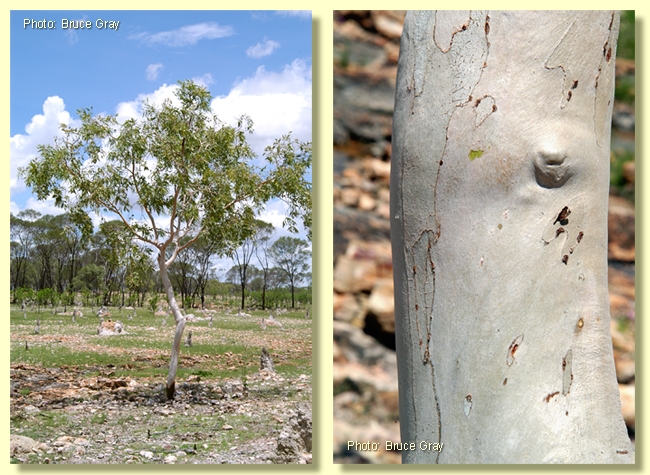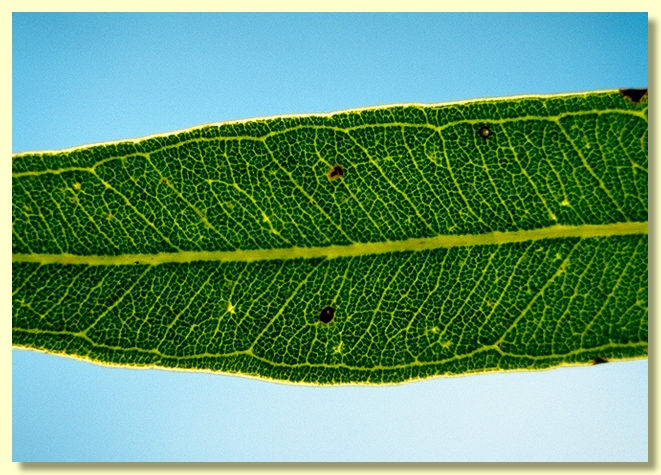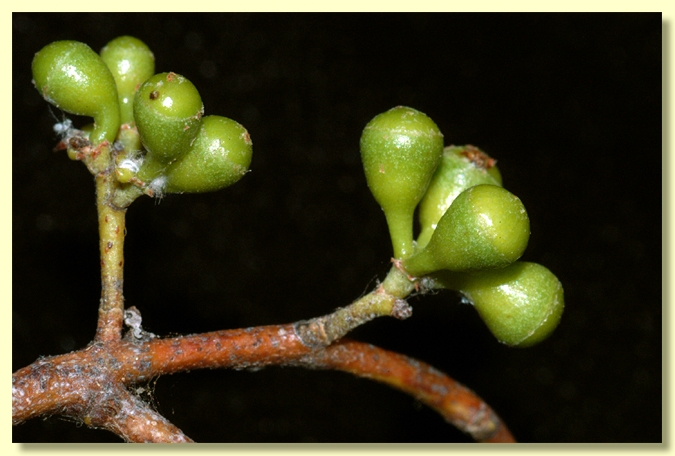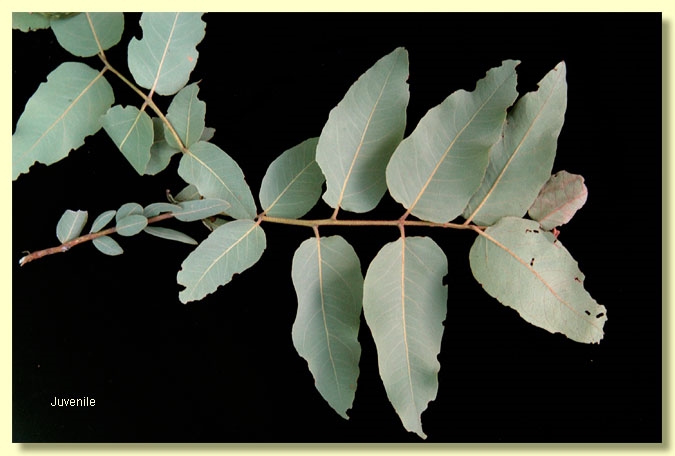Euclid - Online edition
Corymbia gilbertensis
Corymbia | Blakearia
Corymbia gilbertensis (Maiden & Blakely) K.D.Hill & L.A.S.Johnson, Telopea 6: 435 (1995).
Eucalyptus gilbertensis (Maiden & Blakely) S.T.Blake, Austral. J. Bot. 1: 220 (1953); Eucalyptus clavigera var. gilbertensis Maiden & Blakely in J.H.Maiden, Crit. Revis. Eucalyptus 7: 432, t. 283 fig. 8 (1928); T: Queensland: Gilbert River, 11 Feb. 1922, C.T.White 1392; holo: NSW; iso: BRI, MEL.
Tree 12 m tall. Forming a lignotuber.
Bark rough, persistent, tessellated and grey for basal 0.2–1 m of trunk only, then smooth, white to coppery or pale pinkish grey, sometimes powdery. Small trees may be completely smooth-barked.
Branchlets have elongated oil glands or ducts in the pith; younger branchlets setose to scabrid with bristle-glands that bear short simple hairs.
Juvenile growth (coppice or field seedlings to 50 cm): stems rounded in cross-section, setose with bristle-glands bearing simple hairs; leaves opposite to sub-opposite or alternate, shortly petiolate (petioles 0.3–1 cm), ovate to elliptical, 5–13.5 cm long, 2.5–5.3 cm wide, base usually rounded but sometimes lobed, margin usually entire, apex rounded or pointed, green to grey-green, setose.
Crown a mixture of petiolate, dull, green to grey-green, setose, ovate to elliptical to broadly lanceolate juvenile and intermediate leaves, and sometimes also glabrous, green, dull or glossy, linear-lanceolate to lanceolate true adult leaves. The following description applies to all crown leaves: opposite, sub-opposite or sometimes alternate, shortly petiolate, petioles 0.3–1.6 cm long; blade (4)5–13(16) cm long, (0.4)0.7–4.6 cm wide, ± undulate or flat, base slightly lobed or rounded or tapering, margin usually entire, apex pointed or rounded, concolorous, side-veins at greater than 45° to midrib, reticulation dense to very dense, intramarginal vein present, oil glands obscure or minute, island.
Inflorescence axillary compound and condensed, the rhachis consisting of a basal internode ca 0.1–0.4 cm long bearing peduncles of variable length 0.1–0.7 cm long, buds (?3)7 per umbel, pedicels 0.2–1.1 cm long. Mature buds pyriform, 0.5–0.7 cm long, 0.4–0.5 cm wide, smooth, scar present (outer operculum shed early), operculum shallowly rounded, stamens inflexed, all fertile, anthers oblong, dorsifixed, versatile, dehiscing by longitudinal slits, style long and straight, stigma blunt, locules 3 or 4, the ovules arranged in 3 or 4 ± regular vertical rows on the placentae; flowers creamy white.
Fruit pedicellate (pedicels 0.4–1 cm long), cupular to barrel-shape, 0.5–1 cm long, 0.5–0.8 cm wide, thin-walled, disc descending vertically, valves 3 or 4, enclosed.
Seeds not seen (other ghost gum species have brown, saucer-shaped seed, smooth on both sides with hilum ventral).
Cultivated seedlings (measured at ca node 10): cotyledons large, ± orbicular; not grown beyond this stage.
Flowering time not known.
A ghost gum endemic to tropical far north Queensland, found sporadically in the Croydon to Einasleigh area and at Porcupine Gorge north of Hughenden. It occurs as a component of seasonally dry open woodlands on laterite and sandstone, usually in skeletal soil. Corymbia gilbertensis is a small tree with only a short stocking of rough, tessellated bark, otherwise being smooth barked. Some smaller trees may lack rough bark altogether. The crown is predominantly of juvenile to intermediate leaves, i.e. dull, grey-green broad leaves that are rough to touch due to the short bristle-glands, and also a few smooth, narrow, greener adult leaves. Buds occur in reduced compound axillary clusters with only the basal rhachis internode easily visible, variable peduncles to 0.7 cm long and pedicels also variable to 1.1 cm long. The fruit, like those of all ghost gums, are thin-walled.
C. gilbertensis is a poorly known species probably most closely related to C. blakei, which occurs further to the south-west in more arid habitat south-west of Winton. Within the natural range of C. gilbertensis there are several other ghost gum species including C. tessellaris, which has a crown of truly adult glabrous lanceolate leaves, axillary inflorescences with several rhachis internodes clearly visible and a preference for lower lying areas with more moisture; C. confertiflora, which has rough (setose), shortly petiolate cordate to ovate-lanceolate crown leaves to 21 cm long and 10 cm wide, buds and fruit with pedicels to 3 cm long, and a preference for the lower gravelly slopes of foothills; C. grandifolia subsp. grandifolia, which is entirely smooth-barked and has large glossy green glabrous adult leaves and more robust buds and fruit than C. gilbertensis, and prefers floodplains; and C. dallachiana, also smooth-barked and with long lanceolate crown leaves which are petiolate, green and glabrous.
MORE ABOUT CORYMBIA
MORE ABOUT GHOST GUMS
Corymbia gilbertensis: after the Gilbert River in north Queensland, the type locality.













